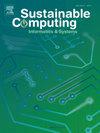基于乘法演算的无人机关键任务非线性能量建模
IF 5.7
3区 计算机科学
Q1 COMPUTER SCIENCE, HARDWARE & ARCHITECTURE
引用次数: 0
摘要
无人机(uav)的能源效率对作战至关重要,其中有效的有效载荷交付、稳定和通信至关重要。为反映无人机载荷重量、风速、高度、速度和通信功率之间的相互依赖关系,提出了一种基于指数标度和乘法演算的无人机非线性能耗模型。与依赖线性或多项式公式的传统方法不同,该方法结合了集成系统的能源需求,重点关注能源消耗。所提出的乘法模型对受变化的环境和操作条件影响的能源权衡提供了有价值的见解。它提高了在具有挑战性、资源受限的环境中使用无人机进行实时援助交付、资源分配和通信的实用性,比传统的能源消耗模型提供了更好的准确性。使用实验数据集的验证表明,与最近建立的用于预测能耗的三次多项式模型相比,所提出的模型的精度提高了85 %。使用均方误差(MSE)和均方根误差(RMSE)作为性能指标来评估所提出的乘法模型的有效性。基本多项式模型的MSE为57.4269,而参数多项式模型将其显著提高到5.7794。相比之下,乘法模型表现出更高的准确性,实现了0.8472的显著较低的MSE。同样,乘法模型在RMSE方面也优于其他模型,其RMSE最小值为0.9205,从而证实了其稳健性和预测可靠性。平均绝对误差(MAE)从6.44降低到0.73,改善了88.66 %。R²值从0.95增加到0.99,表明预测数据与实际数据的拟合程度较好。这些结果强调了乘法模型的稳健性、准确性和可靠性,展示了其在现实世界预测应用中的强大潜力。研究结果表明,该模型更准确地反映了能源消耗,为精确分析和设计提供了坚实的基础。本文章由计算机程序翻译,如有差异,请以英文原文为准。
Nonlinear energy modeling for UAVs in critical missions using multiplicative calculus
Energy efficiency in Unmanned Aerial Vehicles (UAVs) is crucial for operations, where effective payload delivery, stabilization, and communication are essential. This study presents a nonlinear energy consumption model tailored for UAVs, built upon exponential scaling and multiplicative calculus to reflect the interdependencies among payload weight, wind speed, altitude, velocity and communication power. Unlike conventional approaches that rely on linear or polynomial formulations, the proposed method incorporates energy demands from integrated systems, focusing on energy consumption. The proposed multiplicative model provides valuable insights into the energy trade-offs influenced by changing environmental and operational conditions. It improves the practicality of using UAVs for real-time aid delivery, resource allocation, and communication in challenging, resource-constrained environments, offering better accuracy than traditional energy consumption models. Validation using experimental datasets demonstrates that the proposed model achieves an 85 % improvement in accuracy compared to the recently established cubic polynomial model for predicting energy consumption. The effectiveness of the proposed multiplicative model was evaluated using Mean Squared Error (MSE) and Root Mean Squared Error (RMSE) as performance metrics. The basic polynomial model recorded an MSE of 57.4269, while the parametric polynomial model significantly improved this to 5.7794. In comparison, the multiplicative model demonstrated superior accuracy, achieving a markedly lower MSE of 0.8472. Consistently, the multiplicative model also outperformed the others in terms of RMSE, attaining the lowest value of 0.9205, thereby confirming its robustness and predictive reliability. The Mean Absolute Error (MAE) was reduced from 6.44 to 0.73, representing an 88.66 % improvement. Furthermore, the R² value increased from 0.95 to 0.99, indicating a stronger fit between the predicted and actual data. These results underscore the multiplicative model's robustness, accuracy, and reliability, demonstrating its strong potential for real-world predictive applications. The findings demonstrate that the proposed model more accurately represents energy consumption, providing a robust foundation for precise analysis and design.
求助全文
通过发布文献求助,成功后即可免费获取论文全文。
去求助
来源期刊

Sustainable Computing-Informatics & Systems
COMPUTER SCIENCE, HARDWARE & ARCHITECTUREC-COMPUTER SCIENCE, INFORMATION SYSTEMS
CiteScore
10.70
自引率
4.40%
发文量
142
期刊介绍:
Sustainable computing is a rapidly expanding research area spanning the fields of computer science and engineering, electrical engineering as well as other engineering disciplines. The aim of Sustainable Computing: Informatics and Systems (SUSCOM) is to publish the myriad research findings related to energy-aware and thermal-aware management of computing resource. Equally important is a spectrum of related research issues such as applications of computing that can have ecological and societal impacts. SUSCOM publishes original and timely research papers and survey articles in current areas of power, energy, temperature, and environment related research areas of current importance to readers. SUSCOM has an editorial board comprising prominent researchers from around the world and selects competitively evaluated peer-reviewed papers.
 求助内容:
求助内容: 应助结果提醒方式:
应助结果提醒方式:


